Physical Address
304 North Cardinal St.
Dorchester Center, MA 02124
Physical Address
304 North Cardinal St.
Dorchester Center, MA 02124
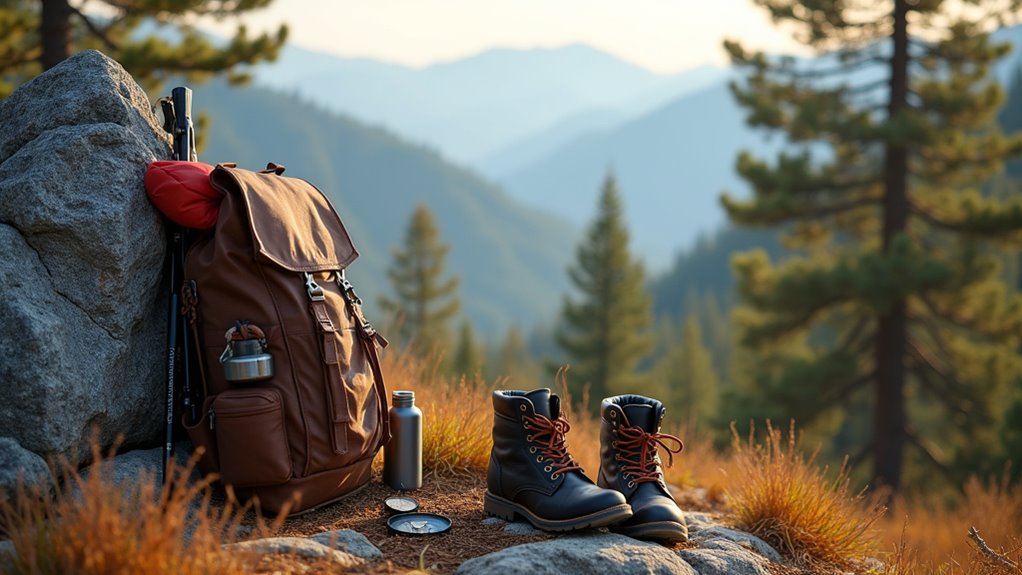
Don't let Instagram-perfect hiking photos fool you—these 12 backpacking secrets could save you from disaster, blisters, and getting hopelessly lost.
You’ve probably scrolled through countless Instagram photos of stunning mountain vistas and thought, “I could do that.” But here’s what those perfectly filtered shots don’t show you: the blisters from ill-fitting boots, the soggy gear from unexpected storms, and the panic when your phone’s GPS dies in the middle of nowhere. Before you blow your savings on fancy equipment or find yourself lost on your first trail, there are twelve critical things that’ll make or break your backcountry experience.
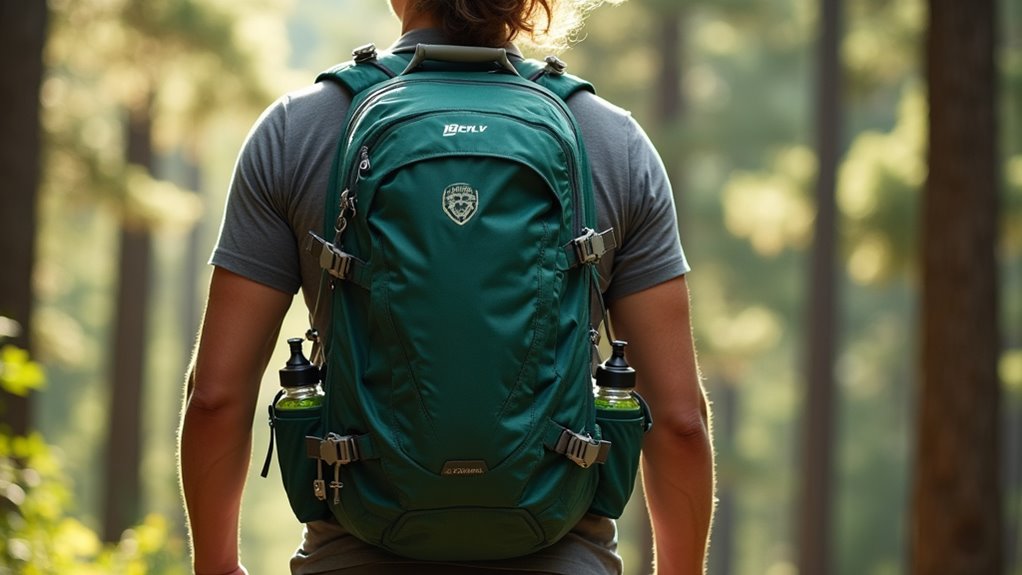
Finding the right backpack doesn’t have to break the bank, but it’ll make or break your entire trip. Focus on capacity first—aim for 40-60 liters for multi-day hikes. Don’t get swayed by fancy features you won’t use.
Visit stores to try different brands since torso length matters more than height. The pack should sit snugly against your back with hip belts resting on your hip bones, not waist. Shoulder straps shouldn’t dig in or gap away from your body.
Torso length trumps height when choosing backpacks—hip belts should rest on hip bones, not your waist.
Test the fit with weight—most good shops have sandbags for this. Walk around for ten minutes minimum. Your hips should carry 80% of the load, not your shoulders.
A properly fitted $150 pack beats an expensive one that doesn’t fit your frame. When selecting your camping backpack, prioritize function over flashy features to ensure it meets your specific outdoor adventure needs.
Every ounce counts when you’re carrying your life on your back for days at a time. You’ll want to scrutinize every item before it goes into your pack. Choose multi-purpose gear whenever possible—a bandana works as a towel, first aid tool, and pot holder.
Ditch cotton clothing for lightweight synthetic materials that dry quickly and pack smaller. Cut your toothbrush handle in half and repackage toiletries into tiny containers. Leave duplicate items at home; you don’t need three knives.
Consider ultralight alternatives like a compact sleeping bag instead of bulky blankets. Weigh everything and keep a gear list to track ounces. Understanding the camping gear essentials will help you make informed decisions about what truly belongs in your pack versus what you can leave behind.

Once you’ve got your pack weight dialed in, you’ll need to map out where you’re actually going. Route planning isn’t just about picking a pretty trail – it’s about staying safe and avoiding costly mistakes that could ruin your trip.
Start by checking recent trail reports, weather forecasts, and permit requirements. Many popular trails require advance reservations that can book up months ahead. Don’t get stuck paying premium prices for last-minute alternatives.
Popular trails book months in advance – do your homework early or pay premium prices for backup options.
Key research priorities:
When exploring unfamiliar territory, take extra time to research new camping sites and their specific regulations before departure.
Weather can make or break your backpacking trip, so you’ll want to dig deeper than just checking the forecast the night before. Study seasonal patterns for your destination—when does rain typically hit? What’s the average temperature range? You can find this free data through NOAA or local ranger stations.
Pack layers instead of expensive single-purpose gear. A lightweight rain jacket doubles as wind protection, and merino wool base layers work in multiple conditions. Check weather apps with hourly forecasts starting three days out, but don’t rely on them completely in mountainous areas.
Always pack emergency shelter like a space blanket—it’s cheap insurance. Know the signs of incoming weather changes: dropping barometric pressure, wind shifts, and cloud formations that signal storms ahead. When organizing your gear, ensure your hiking bag contains all essential items in easily accessible compartments for quick weather response.
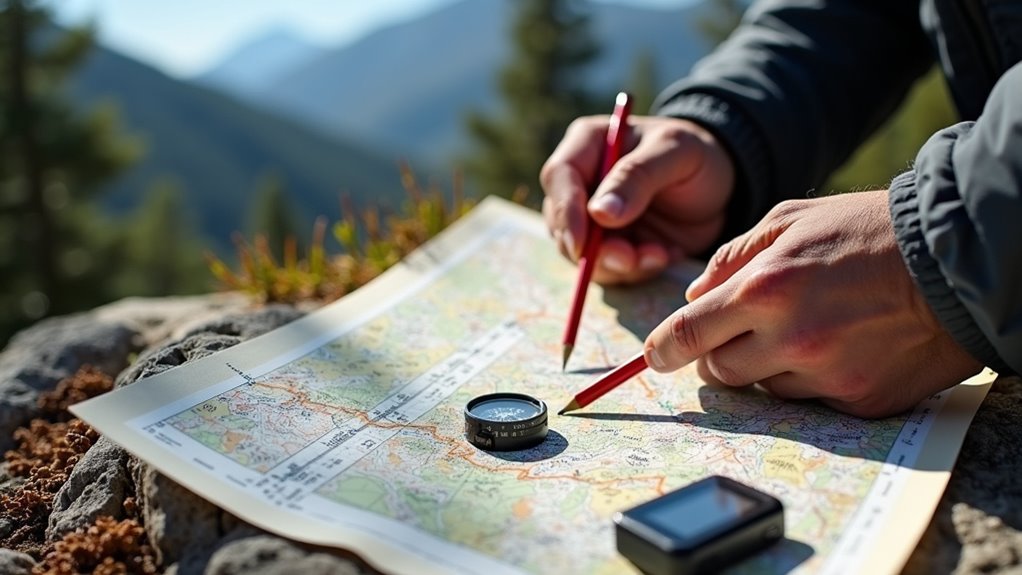
While GPS devices and smartphone apps have revolutionized outdoor navigation, they’ll fail you when batteries die, signals drop, or screens crack against rocks. You need backup skills that don’t require technology or expensive gear.
Master these fundamental navigation techniques:
Invest in a quality topographic map ($12-15) and basic compass ($20-30). These analog tools work in any weather, don’t need batteries, and could save your life when technology fails you. For those seeking more advanced terrain challenges, consider exploring glacier climbing trails which require specialized navigation skills due to constantly changing ice formations and weather conditions.
Though wilderness areas appear resilient, they’re surprisingly fragile ecosystems that millions of visitors impact each year. You’ll protect these spaces by following Leave No Trace’s seven principles without spending extra money.
Plan ahead to use established campsites and trails. Pack out all trash, including food scraps and toilet paper. Camp 200 feet from water sources to prevent contamination. Use a camp stove instead of building fires, which saves money on firewood and prevents scarring.
Dispose of waste properly by digging catholes 6-8 inches deep, or pack out used toilet paper. Don’t pick flowers, move rocks, or feed wildlife. Keep noise levels down and yield trail right-of-way to others. These simple practices cost nothing but preserve wilderness for future backpackers while keeping access open.
Consider joining the share economy for camping gear to reduce your environmental footprint while accessing quality equipment without the full purchase cost.
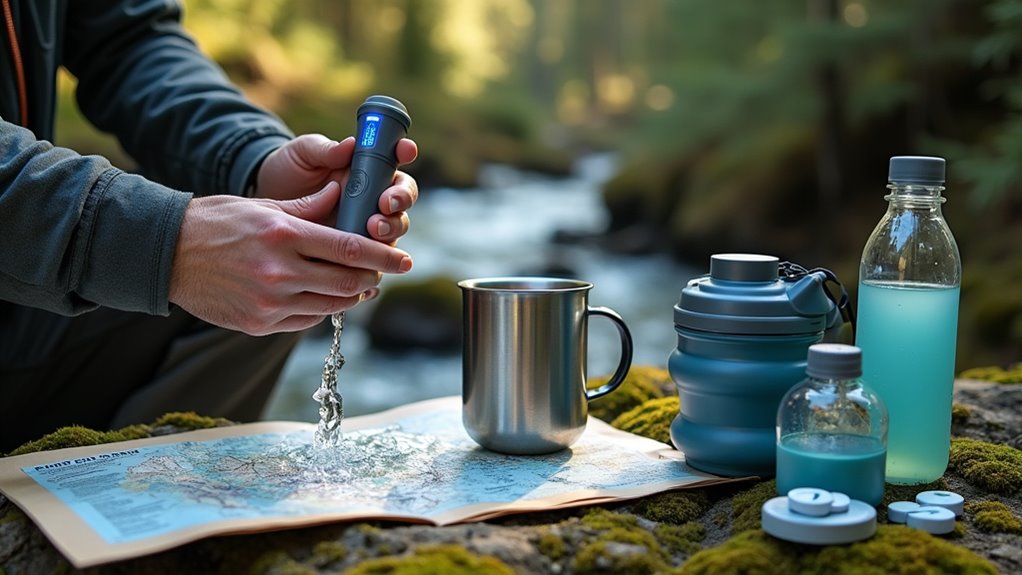
Since dehydration can turn a perfect backpacking trip into a dangerous situation, you’ll need reliable access to clean drinking water throughout your journey. Smart water management starts before you hit the trail by researching water sources along your route and carrying appropriate purification methods.
Smart water management begins with pre-trip planning and reliable purification methods to prevent dehydration emergencies on the trail.
Your water purification toolkit should include budget-friendly options that won’t weigh you down:
Always carry backup purification methods since equipment can fail.
Plan to drink regularly throughout the day rather than waiting until you’re thirsty.
For extended backpacking adventures lasting several days or weeks, investing in quality water filters and purifiers becomes even more critical to ensure consistent access to safe drinking water.
Backpacking meals need to pack maximum nutrition into minimum weight, which means you’ll want to focus on calorie-dense foods that won’t break your budget or your back. Nuts, dried fruits, and nut butters deliver around 500-600 calories per 100 grams.
Instant oatmeal, pasta, and rice provide cheap carbohydrates for sustained energy.
Skip expensive freeze-dried meals and make your own dehydrated options. Dehydrate cooked ground beef, vegetables, and sauces at home using a food dehydrator or oven. Tuna packets, instant mashed potatoes, and dried beans offer protein without refrigeration needs.
Plan for 2,500-4,000 calories daily depending on your activity level. Pack extra food for emergencies, but don’t overpack. Every ounce counts when you’re carrying everything on your back for miles.
Don’t forget to bring the right camp cooking equipment to prepare these meals efficiently on the trail.
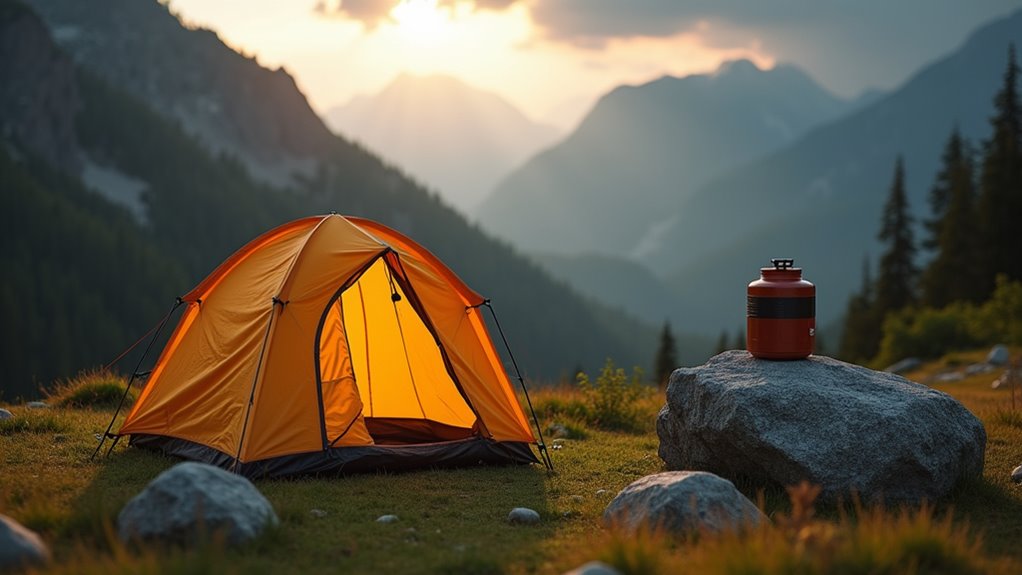
When daylight starts fading, you’ll need to move quickly to establish a secure campsite before darkness sets in. Smart site selection saves time and keeps you comfortable throughout the night.
Look for level ground that’s protected from wind but still allows airflow. Avoid camping in low-lying areas where cold air settles and water might pool during storms. Check overhead for dead branches that could fall, and stay at least 200 feet from water sources to protect wildlife and water quality.
Essential setup priorities include:
Following these camping tips will help ensure your backpacking adventure remains both safe and enjoyable from start to finish.
Your carefully chosen campsite won’t guarantee a wildlife-free night, so you’ll need to know how to handle unexpected animal encounters safely.
Make noise while hiking to avoid surprising animals, especially bears. Store all food, toiletries, and scented items in bear canisters or hang them at least 12 feet high and 4 feet from tree trunks.
If you encounter a bear, don’t run. Make yourself appear large, speak calmly, and back away slowly.
For aggressive bears, play dead by lying face-down with your pack protecting your back.
Mountain lions require different tactics—maintain eye contact, appear large, and fight back if attacked.
Smaller animals like raccoons and rodents can still damage gear and steal food. Keep your tent zipped and never feed wildlife, as this creates dangerous dependencies.
Understanding proper bear safety protocols is essential for any backcountry adventure, as these encounters require specific responses that could save your life.
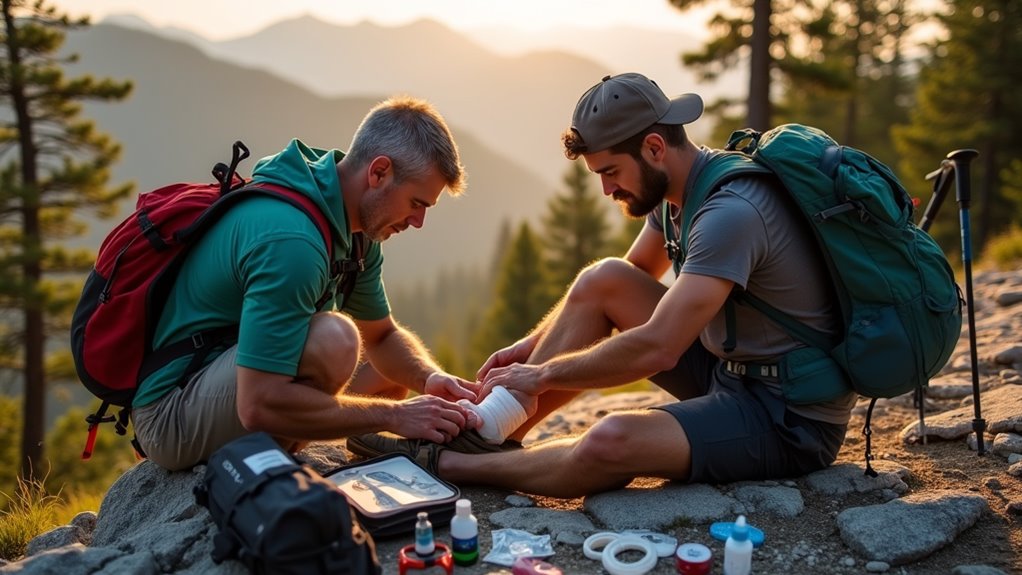
Since medical help can be hours or days away in the backcountry, you’ll need solid first aid skills and a well-stocked kit to handle emergencies yourself. Take a wilderness first aid course before your trip – many community colleges offer affordable options, and the Red Cross provides budget-friendly certification programs.
Your first aid kit doesn’t need to break the bank. Focus on essentials and learn to use everything you pack:
When assembling your first aid kit, prioritize quality over quantity and ensure all items are within their expiration dates. Practice scenarios at home so you’re prepared when it matters.
Beyond physical preparedness and medical training, backpacking tests your mental toughness in ways that catching a bus or grabbing takeout never will. You’ll face discomfort, exhaustion, and unexpected setbacks that’ll challenge your resolve.
Start building resilience at home by embracing uncomfortable situations. Take cold showers, sleep on hard surfaces, or skip meals occasionally. These free practices toughen your mental game without spending money on gear.
Learn basic problem-solving techniques before hitting the trail. When your tent breaks or weather turns nasty, you’ll need creative solutions with limited resources. Practice meditation or breathing exercises to manage stress and anxiety.
Accept that things will go wrong. Rain happens, trails disappear, and equipment fails. Your ability to adapt and stay positive determines whether these become adventures or disasters.
Consider the financial commitment carefully, as the decision between renting or buying equipment can significantly impact your budget and long-term outdoor pursuits.
You’ve got your roadmap to wilderness freedom – now it’s time to lace up those boots and hit the trail. Like Dorothy discovering she had the power all along, you’ve already got what it takes inside you. Don’t let gear envy drain your wallet; start with basics and upgrade as you go. Remember, the best adventures aren’t about having the fanciest equipment – they’re about taking that first step into the unknown.